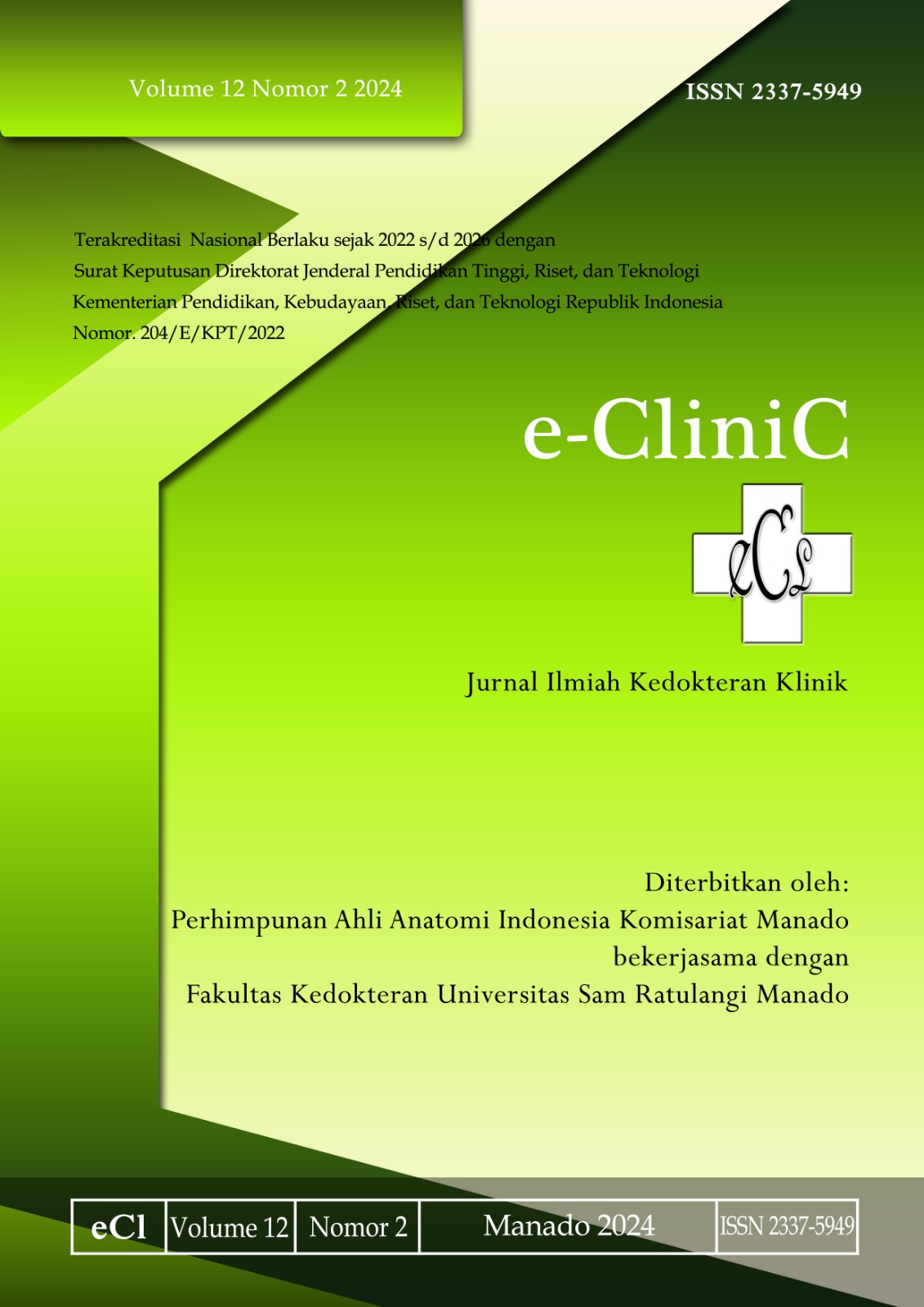Penilaian Kemampuan Prognostic Nutritional Index Memrediksi Lama Penyembuhan Luka Operasi Paska Tindakan Laparotomi pada Pasien Kanker Kolorektal
DOI:
https://doi.org/10.35790/ecl.v12i2.51744Abstract
Abstract: In colorectal cancer, surgical resection is the main curative therapeutic modality for localized, non-metastatic colorectal cancer at any age with good performance status and controlled comorbidities. Nutritional status is known to be a very important factor in the treatment of all types of surgery including preoperative and postoperative aspects. This study aimed to assess the ability of prognostic nutritional index (PNI) to predict the healing time of surgical wounds after laparotomy in patients with colorectal cancer. Samples were patients with colorectal cancer that underwent laparotomy at Prof. Dr. R. D. Kandou Hospital, Manado. The results showed that mean age of patients was 55 years and the mean body mass index (BMI) was 22. Patients with comorbids were 18.2%. The most common duration of wound healing according to Southampton wound grade system was grade 0 (63.6%), followed by grade 1 (18.2%), grade 2 (4.5%), and grade 3 (13.6%). The Spearman test showed a positive correlation between pre-operative PNI and duration of wound healing (r=0.582), and the 2-tailed significancy of 0.000. In conclusion, prognostic nutritional index can predict the duration of post-laparotomy wound healing in colorectal cancer patients.
Keywords: colorectal cancer; prognostic nutritional index; wound healing
Abstrak: Pada kanker kolorektal reseksi pembedahan merupakan modalitas terapi utama yang bersifat kuratif untuk stadium non metastasis yang masih terlokalisasi pada usia berapapun dengan status performance yang masih baik dan komorbiditas terkontrol. Status gizi diketahui menjadi faktor yang sangat penting dalam penanganan seluruh jenis bedah termasuk aspek pre operatif dan post operatif. Penelitian ini bertujuan untuk menilai kemampuan prognostic nutritional index (PNI) dalam memrediksi lama penyembuhan luka operasi paska tindakan laparotomi pada pasien dengan kanker kolorektal. Sampel penelitian ialah pasien dengan kanker kolorektal yang menjalani laparatomi di RSUP Prof. Dr. R. D. Kandou Manado. Hasil penelitian mendapatkan rerata usia pasien ialah 55 tahun dan rerata indeks massa tubuh (IMT) ialah 22. Pasien yang memiliki penyakit penyerta sebesar 18,2%. Lama penyembuhan luka operasi menurut (Southampton Wound Grade System) terbanyak ialah grade 0 (63,6%), diikuti grade 1 (18,2%), grade 2 (4,5%), dan grade 3 (13,6%). Hasil uji korelasi Spearman terhadap korelasi antara PNI pre-OP dengan lama penyembuhan luka operasi bernilai positif 0,582, dengan nilai Sig. (2-tailed) sebesar 0,000. Simpulan penelitian ini ialah prognostic nutritional index dapat memrediksi lama penyembuhan luka operasi paska tindakan laparotomi pada pasien kanker kolorektal.
Kata kunci: kanker kolorektal; prognostic nutritional index; penyembuhan luka operasi
References
Ren X-C, Liu Y-E, Li J, LKin Q. Progress in image-guided radiotherapy for the treatment of non-small cell lung cancer. World J Radiol. 2019 Mar 28; 11(3): 46–54. doi: 10.4329/wjr.v11.i3.46
Kuipers EJ, Grady WM, Lieberman D, Seufferlein T, Sung JJ, Boelens PG, et al. Colorectal cancer. Nat Rev Dis Primers. 2015;1:15065. Doi: 10.1038/nrdp.2015.65
Short WD, Wang X, Keswani SG. The role of T lymphocytes in cutaneous scarring. Adv Wound Care (New Rochelle). 2022;11(3):121-31. Doi: 10.1089/wound.2021.0059
Raslan C, Tomalieh F, Lasheen O, Khurram S. Assessment of malnutrition in emergency laparotomy patients. A QIP highlights simple measures to improve early recognition and optimisation of high-risk patients. J Clin Trials. 2021;12(S12):1-7. Doi: 10.21203/rs.3.rs-706520/v1
Kane V, Talpallikar MC. Study on risk factors for mortality and morbidity in patients undergoing surgery for colorectal cancer. International Surgery Journal. 2019;25;6(8):2766. Doi: 10.18203/2349-2902.isj20193081
Cheng YL, Sung SH, Cheng HM, Hsu PF, Guo CY, Yu WC, et al. Prognostic nutritional index and the risk of mortality in patients with acute heart failure. J Am Heart Assoc. 2017;6(6) e004876. Doi: 10.1161/JAHA.116.004876
Joliat GR, Schoor A, Schäfer M, Demartines N, Hübner M, Labgaa I. Postoperative decrease of albumin (ΔAlb) as early predictor of complications after gastrointestinal surgery: a systematic review. Perioperative Medicine. 2022;11(1):7. Doi: 10.1186/s13741-022-00238-3
Onodera T, Goseki N, Kosaki G. Prognostic nutritional index in gastrointestinal surgery of malnourished cancer patients. Nihon Geka Gakkai Zasshi. 1984;85(9):1001–5. Available from: https://pubmed. ncbi.nlm.nih.gov/6438478/
Yoshida R, Gohara S, Sakata J, Matsuoka Y, Hirosue A, Kawahara K, et al. Onodera’s prognostic nutritional index correlates with tumor immune environment and survival in patients with oral squamous cell carcinoma undergoing chemoradiotherapy. Transl Oncol. 2020;13(12): 100850. Doi: 10.1016/j.tranon.2020.100850
Söderbäck H, Gunnarsson U, Martling A, Hellman P, Sandblom G. Incidence of wound dehiscence after colorectal cancer surgery: results from a national population-based register for colorectal cancer. Int J Colorectal Dis. 2019;34(10):1757–62. Doi: 10.1007/s00384-019-03390-3
Downloads
Published
How to Cite
Issue
Section
License
Copyright (c) 2024 Regina Suatan, Ferdinand Tjandra, Billy Salem, Frederik G. Langi

This work is licensed under a Creative Commons Attribution-NonCommercial 4.0 International License.
COPYRIGHT
Authors who publish with this journal agree to the following terms:
Authors hold their copyright and grant this journal the privilege of first publication, with the work simultaneously licensed under a Creative Commons Attribution License that permits others to impart the work with an acknowledgment of the work's origin and initial publication by this journal.
Authors can enter into separate or additional contractual arrangements for the non-exclusive distribution of the journal's published version of the work (for example, post it to an institutional repository or publish it in a book), with an acknowledgment of its underlying publication in this journal.
Authors are permitted and encouraged to post their work online (for example, in institutional repositories or on their website) as it can lead to productive exchanges, as well as earlier and greater citation of the published work (See The Effect of Open Access).







